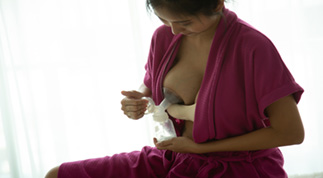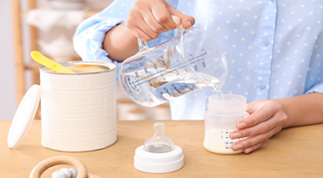Feeding Your Baby the First Six Months
Feeding a newborn is a round-the-clock commitment and can be unpredictable. It's also an opportunity to begin forming a bond with the newest member of your family. Deciding how to feed your baby is an important choice. It is helpful to learn as much as possible about your options to make an informed decision. Breast milk is the ideal food for babies for the first six months — with rare exceptions. If breastfeeding isn't possible, use infant formula. Healthy newborns don't need cereal, water, juice or other fluids for the first six months.
It’s important to get help early and often to support your breastfeeding success. Check out our Prenatal, Breastfeeding, and Parenting Services page to access supports in your community.
Free online breastfeeding and newborn classes
Before baby arrives
From the minute you became pregnant you have been making decisions that affect you, your baby, and your family. Taking the time to educate yourself about the benefits of breastfeeding, techniques, realistic expectations, typical newborn behaviour, and how to get help when you’re struggling will support the success of your breastfeeding journey.
| Benefits of breastfeeding |
|
Human breast milk is the most natural milk to feed your baby, however, breastfeeding is a skill that requires planning, preparation and practice to master. Breastfeeding comes with many benefits:
Learn more about the exclusive benefits of human milk. |
| I have decided to breastfeed, now what? |
|
It is important to prepare for feeding your baby while pregnant so you will feel confident during those first few days after your baby arrives. The choices you make before, during, and after birth will help get breastfeeding off to the best start. Suggestions to prepare for breastfeeding while pregnant include:
|
| Breastfeeding supplies |
| Planning for bringing baby home includes some essential items for newborns (e.g. car seat, diapers, safe sleep).
Here are a few suggestions for supplies to help with breastfeeding:
Avoid buying
Visit About Breastfeeding for more suggestions. |
| Express milk before birth |
Learn more about antenatal hand expression. |
The early days
Getting a good start at breastfeeding during the “early days” can take time and patience. You and baby are both learning a new skill. Remember to take care of yourself and ask for help from others as you rest, recover, and learn to breastfeed.
To learn important information about the early days.
| Tips to get off to a good start |
|
Here are some tips to help you get off to a good start:
|
|
First milk or colostrum |
To learn more about the important health benefits of human milk visit About Breastfeeding. |
| Is my baby getting enough milk? |
|
This is the most common concern from new parents about breastfeeding. You can not measure or see breastmilk when baby is latching and drinking. There are many ways to know if your baby is getting enough milk.
|
Everyday life
Breastfeeding past the early days may bring up further questions as the journey continues and the baby grows, common topics can include pumping, going back to work, breastfeeding in public, teething, weaning and can be found on the About Breastfeeding website.
| Pumping |
|
There are several options for removing milk at the breast, including hand expression, single and double electric pumps, and manual pumps, choosing the right type of milk expression is important and can influence milk supply. Some considerations when thinking about which pump to use are cost, portability, noise level, ease of use, efficiency, and effectiveness of removing milk. For example, a pump that helps to build milk supply would be a hospital grade electric pump, a pump that gently removes milk to reduce engorgement and maintain milk supply is a manual or hand pump. Situations when expression of breast for milk is appropriate:
Strategies to increase your milk supply when pumping include:
The length of pumping time will depend on the milk ejection reflex, but it typically takes 10 to 15 minutes, or longer if milk is still coming out. You may be eligible for financial support for a pump purchase or rental, if you currently receive Ontario Works or Ontario Disability Support Program speak to your worker for more information or contact your employee health care benefits to discuss available support. For more information on pumping visit Health Link BC - Pumping Breast Milk. |
|
Breastfeeding and returning to work or school |
|
Many parents who return to work or school find they can maintain their breastfeeding relationship with their baby. When separated from your baby for long periods of time, you can express and store your breastmilk. Below are some considerations regarding breastfeeding and returning to school/work:
|
|
Starting solids |
|
Most babies need only breast milk and vitamin D for the first six months. Solids are usually introduced when the baby is around six months old, while breastfeeding continues for up to two years or beyond. Breast milk will still remain an important part of your baby’s diet, as it provides immune protection and nutrients to your growing baby. Starting solids introduces important nutrients such as iron and a variety of textures to continue to support your baby’s growth and development. While starting solids it remains important to continue to breastfeed to protect your milk supply. Learn more about Feeding your baby: A guide to help you introduce solid foods |
| Nursing strike |
|
Nursing strike is when a baby who has been breast feeding well suddenly refuses the breast. This mostly occurs before the baby is 12 months old and can last a couple of days or longer. This is not the same as natural weaning when the baby moves from breast milk to other sources of food. Sometimes the cause for the nursing strike is unknown, however the baby could be experiencing an ear infection, a cold or other illness, acid reflux or be stressed, upset or easily distracted. Suggestions to assist with a baby strike could include the following tips:
|
|
Milk storage |
|
How long you can safely store breast milk depends on where you store it, and whether your baby is healthy or sick. Here are helpful tips for storing your breast milk:
|
Fathers, partners, family and friends
Support from fathers, partners, co-parents, family and friends makes a difference and helps families achieve their breastfeeding goals. Working as a parenting team is important and will help you meet the goals you set for your child.
Helpful things to do include:
- Ask what you can do to help make breastfeeding easier.
- Learn different ways to care for baby, such as skin-to-skin holding, changing diapers, bathing, walking, singing, or dancing.
- Assist with housework, and food prep, so the breastfeeding parent has the time and energy to breastfeed.
- Finding breastfeeding resources in your area if needed.
- Sit with the breastfeeding parent while they breastfeeds, provide comfort, understanding, and care.
Learn more by visiting About Breastfeeding.
Common concerns
| Baby is fussy or sleepy at breast |
|
In the early days, your baby might fall asleep while or shortly after breastfeeding. Newborn babies sleep for 14 to 20 hrs a day, in short cycles. Newborns must eat regularly, eight or more times a day, and should be fed once every three hours. You may need to wake your baby to breastfeed until your baby is waking regularly on their own and their back to birth weight. Babies born at 37 weeks or younger, or who have jaundice or other medical conditions, must be monitored closely to ensure they are eating enough milk. For questions or concerns visit Prenatal, Breastfeeding, and Parenting Services. How to help a sleepy baby:
|
| Baby will not latch |
|
If your baby is not latching or drinking at the breast you will want to make sure your baby is being well fed and your milk supply is maintained. Pumping your breast at least eight times in 24 hours and feeding your baby your expressed milk may be necessary as you work to get your baby onto the breast. Speak to a health care professional as soon as possible about ways to feed your baby which will not negatively impact breastfeeding. Spend time with your baby skin-to-skin and keep trying to latch the baby and breastfeed. Remember that most babies will eventually take the breast. To get breastfeeding help visit Prenatal, Breastfeeding, and Parenting Services. |
| Painful latch |
|
Breastfeeding shouldn’t hurt, if there is pain while breastfeeding, there could be issues with the latch. If the latch is painful, this can lead to skin breakdown, blocked ducts or blebs, may lead to ineffective milk removal and should be corrected quickly. Reviewing proper position and latch techniques at About Breastfeeding can be a great place to start. To get breastfeeding help visit Prenatal, Breastfeeding, and Parenting Services. |
| Breastfeeding multiples |
For more tips on breastfeeding your multiples, please visit: Multiple Births Canada - Feeding. |
Formula
Tips on how to prepare and feed your baby formula:
Contact Us











